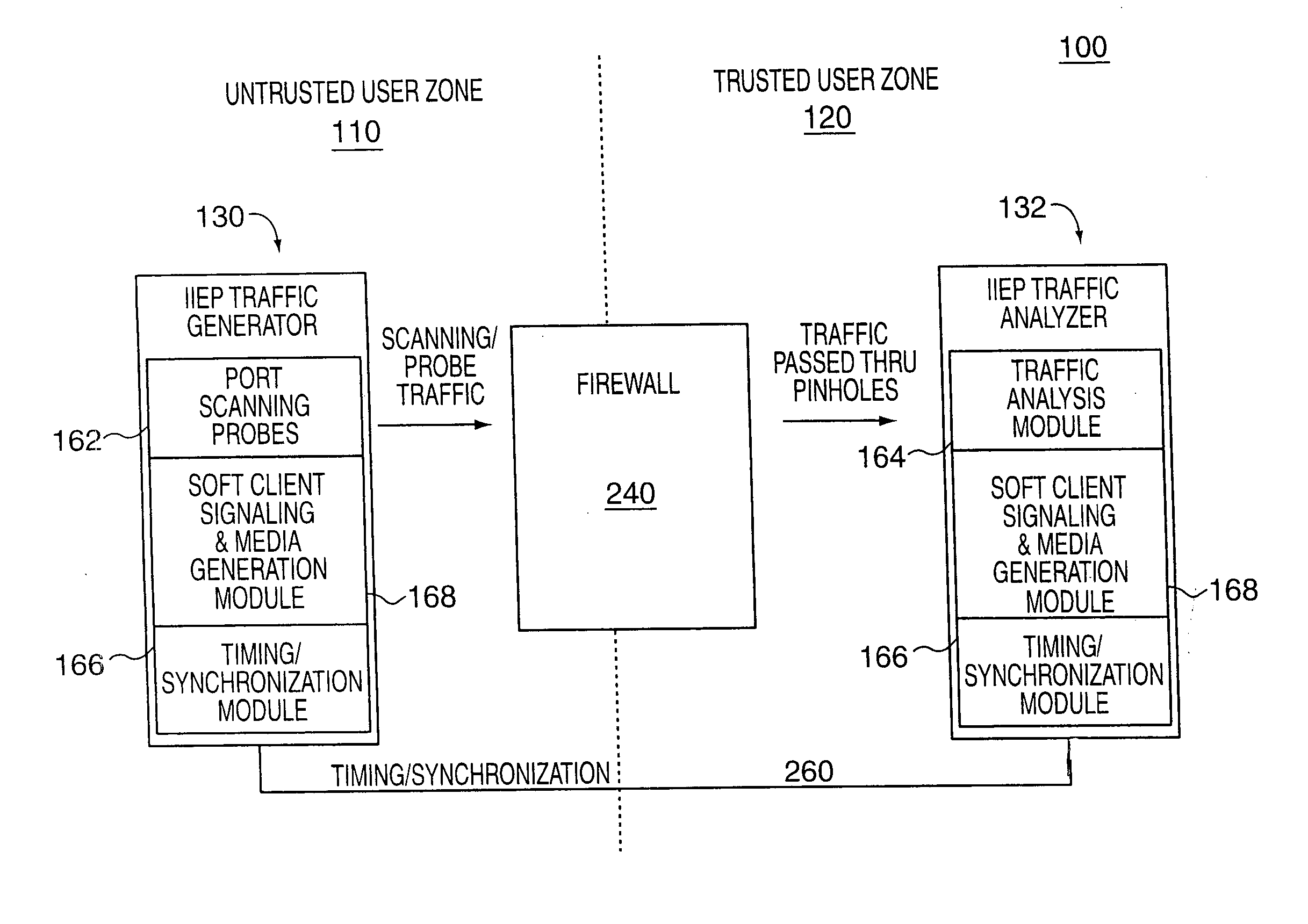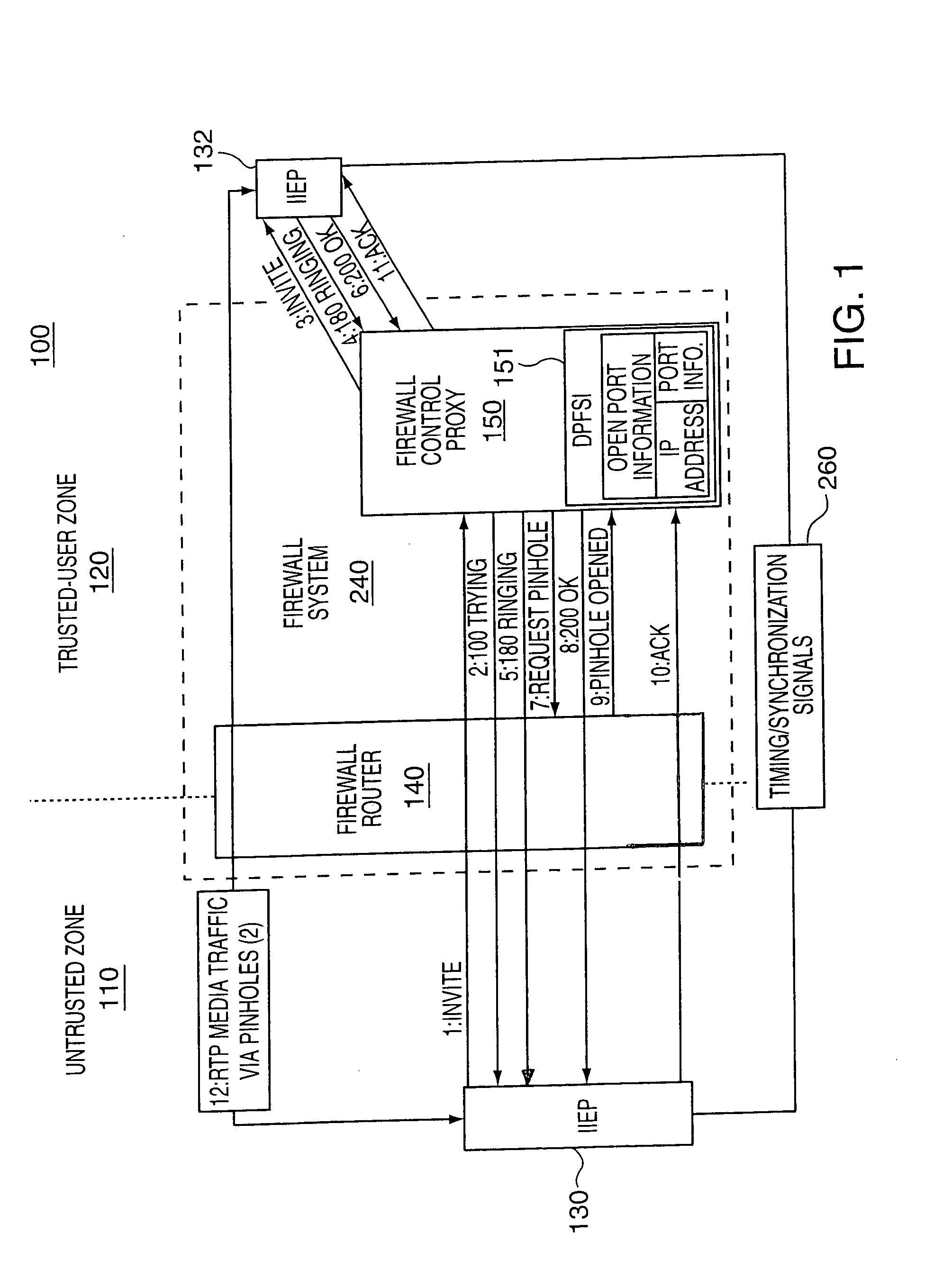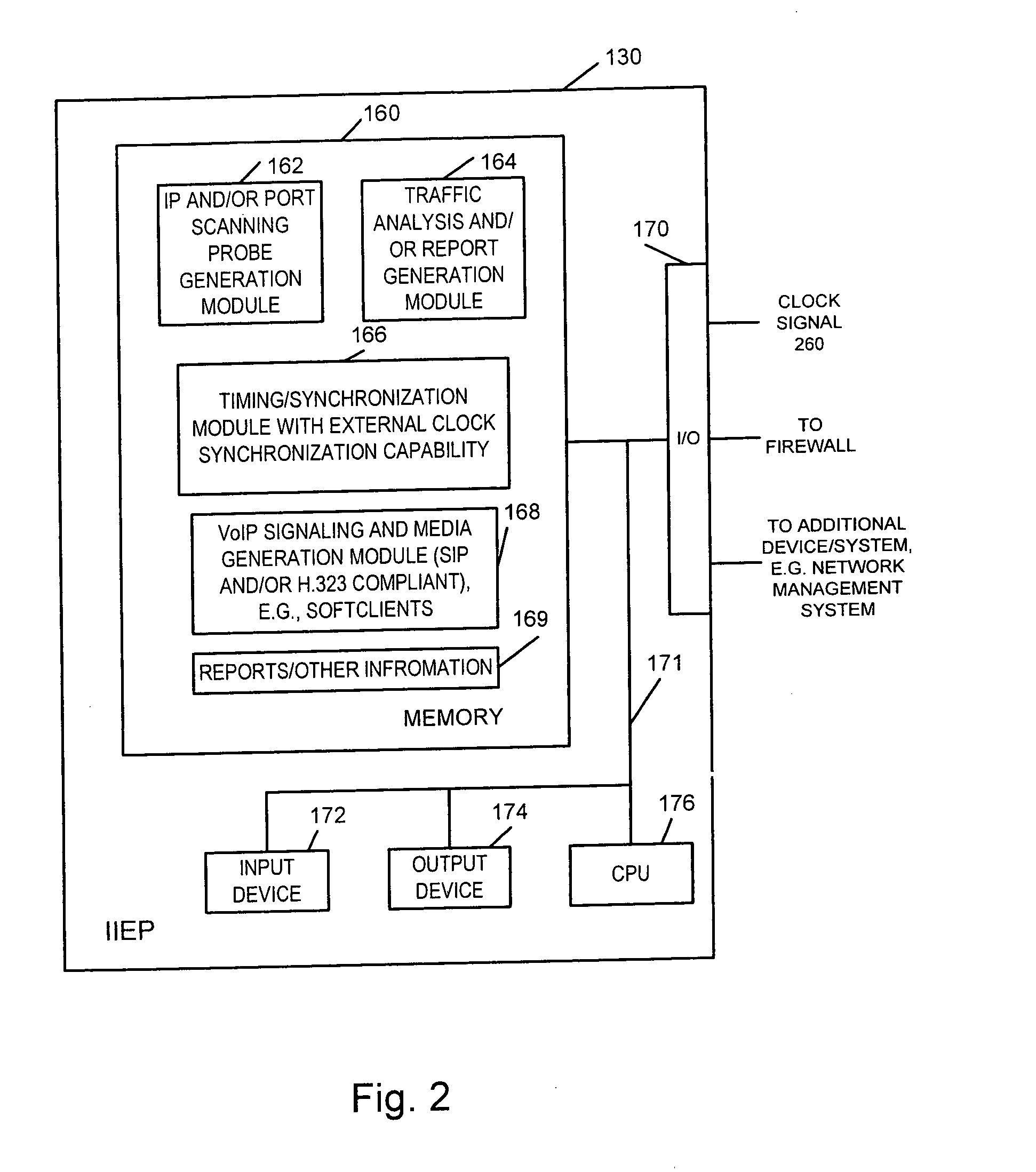[0011] Among the features to which the present invention is directed are 1) test apparatus and a testing
system; 2) testing methods involving: a) checking whether firewall ports are open and / or closed as dictated by various firewall rules and / or b) opening and / or closing delays associated with opening and closing ports in response to session signals used to establish and / or terminate media sessions; 3) determining the effect of increasing traffic loads, e.g., session signaling loads, on firewall port opening and / or closing delays; and 4) the monitoring of an active firewall to a) detect the effect of traffic loading on port opening and / or closing delays, b) generate an alarm when a detected opening and / or closing delay exceeds a pre-selected threshold; and c) taking one or more actions in response to a generated port opening or closing delay alarm to reduce the load on the firewall to which the alarm corresponds and / or take other measures to ensure that firewall security is maintained. Additionally, by way of example, a time / spatial fault
detector coupled with a root-
cause analysis engine could help sectionalize in time and space where and when one or more security violations have occurred in a large network. This may be done by correlating the output of various port opening and closing
delay time monitoring devices deployed throughout the network to determine the cause and locality of actions which interfere with proper firewall operation. The time / spatial fault
detector and root-
cause analysis engine are, in some embodiments, included in a
security management system which receives input from multiple firewalls and / or monitoring systems distributed throughout the network.
[0018] The effect of traffic loading is tested in various embodiments by increasing firewall traffic, e.g., session signaling which triggers the opening and / or closing ports, and measuring the corresponding opening and closing delays for different traffic loads. A given firewall may be specified with maximum acceptable port opening and / or closing delay threshold values, e.g., pinhole opening and / or closing delay threshold times. It is possible, based on testing, in accordance with the present invention, to determine the maximum
traffic load for the given firewall before the operational opening and / or closing delays will exceed the maximum acceptable threshold values, e.g., maximum opening and / or closing delay times. Different thresholds may be used to define the maximum acceptable opening and closing delays. Determining this information facilitates correct
engineering of a firewall
system so that it will
handle the expected loads.
[0019] Different processors may be tested in a given firewall application to determine the maximum
traffic load they can support for a maximum permitted closing and / or opening delay. By combining this information with expected
traffic load information, processors are, in some implementations, selected based on the testing methods of the present invention to match anticipated traffic loads thereby permitting cost effective investment and hardware deployment.
[0020] The test methods of the present invention which are used to determine port opening and closing delays may be, and in some embodiments are, used in an active network. In such cases, the amount of test traffic generated at any given time is kept to a minimal amount to avoid interfering with actual traffic. A maximum closing delay threshold is set in some embodiments. The closing delay is monitored through limited testing on an ongoing and / or periodic basis. This may be done by establishing a call from a device having a particular IP addresses associated with it, directing probe signals at the range of ports which can be associated with the particular
IP address and measuring opening and / or port closing times based on the time signals are detected passing through the firewall and / or stop passing through the firewall through one or more ports associated with the particular
IP address being used for the test call. Closing delays approaching and / or exceeding the maximum acceptable closing delay are reported to the
security management system. The
security management system then takes steps to reduce the load on the firewall, e.g., by modifying
network routing parameters to reduce the traffic directed to the firewall and / or by controlling the node in which the firewall is located to drop traffic, e.g., traffic above a pre-selected threshold.
System administrators are notified of closing delay problems so that they can
upgrade the affected firewall and / or take other steps to address firewall problems. Correlation from various firewall monitoring modules and / or other devices distributed throughout the network can be used to analyze in space and time when / where a security problem, such as excessive port closing delays, is occurring and feed the information into an analysis tool to identify a
root cause of the problem and / or the location of the cause of the problem, thereby enabling further action.
[0022] In most but not all embodiments, the IIEPs of the present invention include both
signal generation, e.g., traffic and
test probe signal generation, capabilities as well as monitoring / analysis abilities. Thus, when used in pairs with one IIEP located inside the trusted zone and another located in the untrusted zone, it is possible to generate traffic in both directions and determine if the firewall operates properly in regard to each of a pair of uni-directional ports that may be involved in an established test call. The IIEPs of the present invention include sufficient logic that one device is able to initiate a call with each device then generating and transmitting
test probe signals to check the status of the ports in each direction. The results of the firewall testing, determined by each of the IIEPs e.g., in regard to one direction of probe test
signal flows, may be combined into a single report by the IIEPs which operate together in a synchronized manner. The analysis module in the IIEP on the trusted side of the firewall may perform this function.
[0023] Our inventive method may proceed in stages, by verifying pinhole operation according to a set of static rules (IP address and / or port rules) as well as verifying pinhole operation according to a set of dynamic rules, e.g., rules associated with opening and / or closing ports in response to session signaling in a timely manner. Our inventive method advantageously verifies the dynamic rule operation from a traffic source compliant with the static rules, adding further credence to the certification of proper dynamic rule operation and compliance.
 Login to View More
Login to View More  Login to View More
Login to View More 


